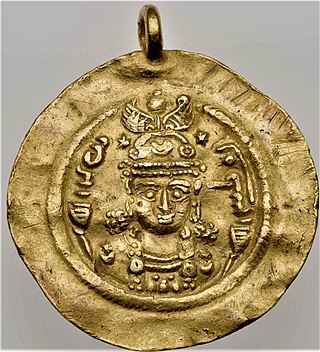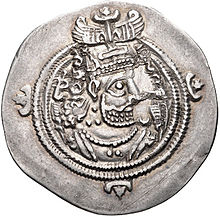
Khosrow I, traditionally known by his epithet of Anushirvan, was the Sasanian King of Kings of Iran from 531 to 579. He was the son and successor of Kavad I.

Yazdegerd III was the last Sasanian King of Kings of Iran from 632 to 651. His father was Shahriyar and his grandfather was Khosrow II.

Balash was the Sasanian King of Kings of Iran from 484 to 488. He was the brother and successor of Peroz I, who had been defeated and killed by a Hephthalite army.

Bahram II was the fifth Sasanian King of Kings (shahanshah) of Iran, from 274 to 293. He was the son and successor of Bahram I. Bahram II, while still in his teens, ascended the throne with the aid of the powerful Zoroastrian priest Kartir, just like his father had done.

Shapur I was the second Sasanian King of Kings of Iran. The precise dating of his reign is disputed, but it is generally agreed that he ruled from 240 to 270, with his father Ardashir I as co-regent until the death of the latter in 242. During his co-regency, he helped his father with the conquest and destruction of the city of Hatra, whose fall was facilitated, according to Islamic tradition, by the actions of his future wife al-Nadirah. Shapur also consolidated and expanded the empire of Ardashir I, waged war against the Roman Empire, and seized its cities of Nisibis and Carrhae while he was advancing as far as Roman Syria. Although he was defeated at the Battle of Resaena in 243 by Roman emperor Gordian III, he was the following year able to win the Battle of Misiche and force the new Roman emperor Philip the Arab to sign a favorable peace treaty that was regarded by the Romans as "a most shameful treaty".

Atropatene, also known as Media Atropatene, was an ancient Iranian kingdom established in c. 323 BC by the Persian satrap Atropates. The kingdom, centered in present-day northern Iran, was ruled by Atropates' descendants until the early 1st-century AD, when the Parthian Arsacid dynasty supplanted them. It was conquered by the Sasanians in 226, and turned into a province governed by a marzban ("margrave"). Atropatene was the only Iranian region to remain under Zoroastrian authority from the Achaemenids to the Arab conquest without interruption, aside from being briefly ruled by the Macedonian king Alexander the Great.

Vologases V was King of Kings of the Parthian Empire from 191 to 208. As king of Armenia, he is known as Vologases II. Not much is known about his period of kingship of Armenia, except that he put his son Rev I on the Iberian throne in 189. Vologases succeeded his father Vologases IV as king of the Parthian Empire in 191; it is uncertain if the transition of power was peaceful or if Vologases took the throne in a civil war. When Vologases acceded the Parthian throne, he passed the Armenian throne to his son Khosrov I.

Boran was Sasanian queen (banbishn) of Iran from 630 to 632, with an interruption of some months. She was the daughter of king Khosrow II and the Byzantine princess Maria. She is the second of only three women to rule in Iranian history, the others being Musa of Parthia, and Boran's sister Azarmidokht.

Touraj Daryaee is an Iranian Iranologist and historian. He currently works as the Maseeh Chair in Persian Studies and Culture and the director of the Dr. Samuel M. Jordan Center for Persian Studies at the University of California, Irvine.

Mazun was a Sasanian province in Late Antiquity, which corresponded to modern-day Bahrain, Qatar, United Arab Emirates, and the northern half of Oman. The province served as a Sasanian outpost and played an important role in the Sasanian efforts to gain control over the Indian Ocean trade, and to establish their dominance in the wealthy regions of Hadramaut and Yemen.

The Sasanian Empire or Sassanid Empire, officially known as Eranshahr, was the last Iranian empire before the early Muslim conquests of the 7th to 8th centuries. Named after the House of Sasan, it endured for over four centuries, from 224 to 651, making it the second longest-lived Persian imperial dynasty after the Arsacids of the Parthian Empire.

Pabag was an Iranian prince who ruled Istakhr, the capital of Pars, from 205 or 206 until his death sometime between 207 and 210. He was the father, stepfather, grandfather, or father-in-law of Ardashir I, the founder of the Sasanian Empire. He was succeeded by his eldest son, Shapur.

Azarmidokht was Sasanian queen (banbishn) of Iran from 630 to 631. She was the daughter of king (shah) Khosrow II. She was the second Sasanian queen; her sister Boran ruled before and after her. Azarmidokht came to power in Iran after her cousin Shapur-i Shahrvaraz was deposed by the Parsig faction, led by Piruz Khosrow, who helped Azarmidokht ascend the throne. Her rule was marked by an attempt of a nobleman and commander Farrukh Hormizd to marry her and come to power. After the queen's refusal, he declared himself an anti-king. Azarmidokht had him killed as a result of a successful plot. She was, however, killed herself shortly afterwards by Rostam Farrokhzad in retaliation for his father's death. She was succeeded by Boran.

Adurbadagan was a Sasanian province located in northern Iran, almost corresponded to the present-day Iranian Azerbaijan. Governed by a marzban ("margrave"), it functioned as an important frontier region against the neighbouring country of Armenia.

Farrukh Hormizd or Farrokh Hormizd, also known as Hormizd V, was an Iranian prince, who was one of the leading figures in Sasanian Iran in the early 7th-century. He served as the military commander (spahbed) of northern Iran. He later came in conflict with the Iranian nobility, "dividing the resources of the country". He was later killed by Siyavakhsh in a palace plot on the orders of Azarmidokht after he proposed to her in an attempt to usurp the Sasanian throne. He had two children, Rostam Farrokhzad and Farrukhzad.

Sasanian Egypt refers to the brief rule of Egypt and parts of Libya by the Sasanian Empire, following the Sasanian conquest of Egypt. It lasted from 618 to 628, until the Sasanian general Shahrbaraz made an alliance with the Roman Byzantine emperor Heraclius to have control over Egypt returned to him.

Shapur was an Iranian prince, who was the penultimate King of Persis from 207–210 to 211/2. He was succeeded by his younger brother Ardashir I, who founded the Sasanian Empire.

The Kings of Persis, also known as the Darayanids, were a series of Persian kings, who ruled the region of Persis in southwestern Iran, from the 2nd century BCE to 224 CE. They ruled as vassal kings of the Parthian Empire, until they toppled them and established the Sasanian Empire. They effectively formed some Persian dynastic continuity between the Achaemenid Empire and the Sasanian Empire.
The Plague of Shiryue (627–628) or Shiruye's Plague takes its name from the Sasanian monarch Kavad II, whose birth name was Shiruye. The plague was an epidemic that devastated the western provinces of the Sasanian Empire just before the Arab Invasion, mainly Mesopotamia (Asorestan), killing half of its population, including the reigning Sasanian king Kavad II, who died in the fall of 628 CE, only a few months into his reign. It killed more than 100,000 people in Ctesiphon.


















